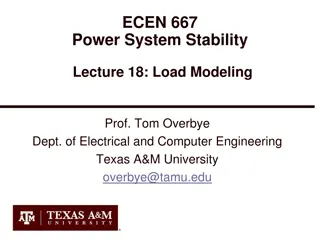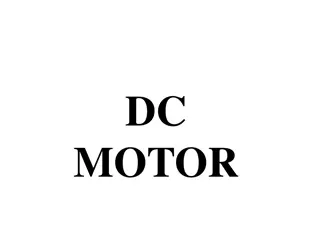Comparison of Compound DC Motors and Their Characteristics
Compound DC motors, including cumulative, differential, and compound configurations, offer unique operational features based on how the series and shunt field windings are connected. Cumulative compound motors provide improved torque characteristics but lower speed, while differential compound motors can reach uncontrollable speeds under certain conditions. Each configuration has its advantages and limitations, making them suitable for specific applications in industries like manufacturing and automation.
Download Presentation

Please find below an Image/Link to download the presentation.
The content on the website is provided AS IS for your information and personal use only. It may not be sold, licensed, or shared on other websites without obtaining consent from the author.If you encounter any issues during the download, it is possible that the publisher has removed the file from their server.
You are allowed to download the files provided on this website for personal or commercial use, subject to the condition that they are used lawfully. All files are the property of their respective owners.
The content on the website is provided AS IS for your information and personal use only. It may not be sold, licensed, or shared on other websites without obtaining consent from the author.
E N D
Presentation Transcript
Lecture # 9 Lecture # 9 COMPOUND DC MOTOR
COMPOUND DC MOTOR o Compound motor combines the effect of both a shunt and seriesfield. o Can be wired in either a long shunt or a short shuntconfiguration. o Under no-load or light load conditions, the series field current will be very small and the shunt field will have its full excitation. Therefore, the motor behaves like a shunt motor and does not approach dangerously high speeds. Long Shunt Short Shunt
DIFFERENTIAL COMPOUND DC MOTOR o Differential Compound: the series and shunt field windings are connected in such a way that their fields oppose eachother. Vt T = ka f sIa Speed = ka f s o where ?frepresents the shunt field flux and ?srepresents the series fieldflux. o As the load increases, both Iaand ?swill increase, causing the term (?f- ?s) decreases, the increase in current predominates over the decrease influx. o Thus, the induced torque (T) will increase and the motor speed will increase too, and the motor may reach an unsafe uncontrollable speed or "run away" very quickly. (undesirable and dangerous). o The differential compound motor maintains even better constant speedwithin its load limit than the shunt motor. But it has very poor starting torque and is unable to handle serious overloads. The differential compound motor has very few practicalapplications.
CUMULATIVE COMPOUND DC MOTOR o Cumulative Compound: the shunt and series windings are connected so that their respective fields aid each other. Vt Speed = T = ka f + sIa ka f + s o As the load increases, the mmf of the series increases but the mmf of theshunt field remains constant. The total mmf is greater under load that atno-load. o An increase in load causes Ia to increase, producing a larger torque (T)which is greater than the shunt and the net flux will increase aswell. o The motor speed falls with increasing load and the speed drop from no-loadto full-load. o The cumulative compound motor has somewhat higher starting torque thana shunt motor of the same rating. Compounding improves the torque characteristic and degrades the speed characteristic. 30
COMPOUND DC MOTOR CUMULATIVE COMPOUND Cumulative compound Torque T = ka f + sIa Differential compound Vt Speed = ka f + s Armaturecurrent DIFFERENTIAL COMPOUND Differential compound Speed T = ka f sIa Vt Cumulative compound Speed = ka f s Armaturecurrent
COMPARISON OF DC MOTORS Cumulative compound Shunt Series Torque Differential compound Speed Series Differential compound Armaturecurrent Shunt Cumulative compound Armaturecurrent
STARTING DC MOTORS If we examine the 120V/10A shunt DC motor shown in the figure andcalculate the currents at starting, the need for a special device becomesapparent. At starting the speed ( ) ) is zero, the back EMF (Eg) is zero.Thus, =120 0=120A Vt Eg Ia _ start= 1 Ra If =Vt=120 = 2A Rf IL_start= Ia _start+If=122A IL_start %Increase = 60 122 100 = 100 =1220% 12 I I starting rated 10 IL _rated This not only might damage the source, but the motor brushes wouldmost likely burn up. In addition, the motor s armature winding which is rated at 10A, would burn.
STARTING DC MOTORS If we examine the 120V/10A shunt DC motor shown in the figure andcalculate the currents at starting, the need for a special device becomesapparent. At starting the speed ( ) ) is zero, the back EMF (Eg) is zero.Thus, Vt Eg Ra =120 0 = 120A Ia_start= 1 t V Rf 120 60 fI = = = 2A IL_start = Ia_start + If = 122A IL_start 122 12 I %Increase = 100 = 100 = 1220% I starting rated 10 IL_rated This not only might damage the source, but the motor brushes wouldmost likely burn up. In addition, the motor s armature winding which is ratedat 10A, would burn. 34
COMPOUND DC MOTOR Example 5-8: A long shunt cumulatively compound motor is run at full load. It is rated 120 V, 15A, 140 rad/s. If Rf =100 , Ra=0.8 , Rs=0.2 , and the stray losses are 65 W,find; Sol. Pi Po Pdev a) The backEMF If = Vt/Rf =120/100 = 1.2A Pcu Pst Ia = IL If = 15-1.2 =13.8A Eg = Vt Ia(Rs+Ra) = 120-13.8(0.2+0.8)=106.2 V b) The output power rating Po = Pin PLosses PLosses = Pcu + Pst = I2Rf PLosses=1.22 100+13.82(0.8+0.2)+65=399.44W +I2Ra+I2Rs +Pst a a f Pi= VtIL=120 15 =1800W PLosses = I2R +I2(R +R ) + P f f a a s st Po=1800 399.44 =1400.54 W 1400W 35
COMPOUND DC MOTOR Example 5-8: A long shunt cumulatively compound motor is run at full load. It is rated 120 V, 15A, 140 rad/s. If Rf =100 , Ra=0.8 , Rs=0.2 , and the stray losses are 65 W,find; Sol. (cont.) c) The efficiency % =Po 100=1400 100=78% Pi 1800 d) The torque rating To =Po =1400 = 10 N.m. 140 or Pdev = Eg Ia= 106.2 13.8=1465 W e) The developed torque Pdev = Po + Pst = 1400+65=1465W Tdev =Pdev =1465 = 10.46N.m. 140 36
COMPOUND DC MOTOR Example 5-9: A short shunt compound motor is 5kW, 240V, and draws a line current of 24A. If Rf =200 , Ra=0.4 , and Rs=0.05 , find at rated load: a) the total copperlosses, b) the stray power losses, c) the efficiency, d) the backEMF. Sol. a) Vf = Vt IL Rs = 240 24 (0.05) = 238.8 V If = Vf /Rf = 238.8/200 = 1.194A Ia = IL If = 24-1.194 =22.81A Pcu =I2R +I2R +I2 R =(24)20.05+(1.194)2200+(22.81)20.4 = 522W b) Pst = Pi Pcu Po = (240) 24 522 5000 = 238W L s f f a a Po Pi 5000 240 24 c) % = x 100 = x100=86.8% d) Eg = Vt IL Rs IaRa = 240 (24) (0.05) (22.81)(0.4) = 229.68 V Pi = VtIL ; 37
SHUNT DC MOTOR Example 5-10: A 4-pole, 220-V shunt motor has 540 lap-wound conductor. It takes 32 A from the supply mains and develops output power of 5.595 kW. The field winding takes 1A. The armature resistance is 0.09 and the flux per pole is 30 mWb.Calculate: a) the speed and b) the shaft torque inN.m. Sol. Ia= 32 1 = 31A a) Eg = Vt Ia Ra = 220 31 0.09 = 217.2 V 2 aEg Z P E =Z P 2 a = and a=P g 2 4 217.2 540 4 30 10 3 = =84.2 rad/s (or 804.4 rpm) b) To =Po =5595 = 66.4 N.m 84.2 38























